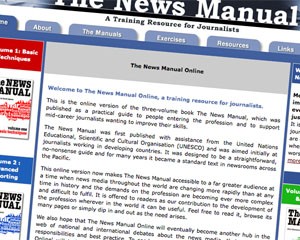|
The following interview about The News Manual Online was conducted by British journalist Judith Townend for journalism.co.uk on 14 October 2008.
_______________________________________
PNG's News Manual goes global with online edition
 A news resource first designed for journalists and journalism students in the Asia-Pacific region has been launched as a free online service for journalists. A news resource first designed for journalists and journalism students in the Asia-Pacific region has been launched as a free online service for journalists.
First published by two journalists, working in Papua New Guinea in the 1990s, the News Manual was a three volume book part-funded by UNESCO. It has now been revised, updated and placed online as 72 indexed chapters, which cover the topics of advanced reporting, ethics and law.
Its new online presence allows it to link to professional sites, discussions and resources.
Journalism.co.uk talked to one of the original authors, David Ingram.
What's the aim of the manual?
[DI]It's a resource. It can help people write news, navigate legal issues or become better-informed journalists, but the real work has to take place in the individual themselves.
I want The News Manual Online to practise what Peter Henshall [his co-author] and I always taught – that journalists may spend our lives chasing that chimera called 'Truth' and never quite nail it down, but every day we can practice honesty.
What's the background?
In the mid-1980s, Peter Henshall and I set up the region's first journalism degree program at the University of Papua New Guinea. We’d both come from British journalism backgrounds – with stints teaching in developing countries - and we had to produce our own teaching material because there was not much around at the time.
We kept the language straightforward and from a culturally diverse perspective, so it could be used in both developed and developing countries.
I guess we were a little surprised at how well it was received. The first print run sold out very quickly. Peter died suddenly in 1992 and the opportunity never arose to reprint. When I eventually retired from full-time work as a broadcasting manager here in Sydney, I set myself the task of updating it and republishing on the internet, along with Sara Diop, an Australian web creator.
You were originally based in PNG, but does it apply more broadly than that?
The News Manual always had a wider reach than just PNG and feedback from throughout the Asia-Pacific region was that it spoke to people of diverse backgrounds. Since going online, the response has been even wider and I've been contacted by journalists, educators and students from as far afield as India and South Africa, Belgium and Hawaii, Britain and Abu Dhabi. I'm told it's now even a course text at a Jesuit university in Pennsylvania. They all think it works for them, which is gratifying.
You cover lots of legal ground, which country's laws do you follow?
It's mainly based on the Commonwealth legal system, a tradition going back to English common law and now used by most English-speaking countries – and some non-English speaking nations too.
Any international resource is a compromise between being detailed about one specific country or generalised about many. It's a balance one has to strike, but again, it seems to work for site visitors from a wide variety of countries.
There's an additional 'bonus' section about Australian media law, simply because in my years of training for Australian broadcasters I'd accumulated a lot of country-specific information which it seemed a shame not to offer online.
You've just made the jump online, what do you see as the advantages of that?
There are so many, where does one start? Briefly then, it's accessible all over the world, even in places where books are hard to get or expensive to buy. The site was built to be usable even for people with slow dial-up connections – which is still a lot of people in developing countries, even in newsrooms. It's also cheap to publish online. Because we wanted it to be free, we couldn't invest heavily in production.
Sara Diop built the site structure and I taught myself the rudimentaries of Dreamweaver so I could populate it. There were more than half-a-million words, 70-plus chapters and dozens of illustrations, so for some months I lived and breathed this project.
Publishing on the net also allows you to update and correct information quickly, without new print runs. That means it can be more up-to-date, important in the rapidly evolving world of journalism.
What can we expect to see in coming months?
I thought my work on The News Manual was mostly finished but I now realise that nothing in the online world is ever set in stone.
As well as an ever-expanding section of links – now 166 and growing – and the special features, I want to expand the exercises section for journalism educators and people teaching themselves journalism, maybe as citizen journalists and bloggers.
I also want to look at a CD ROM version of the site, because many journalists in developing countries still have problems with internet access even though they now have laptops.
I think journalists in the west tend to think of ourselves at the frontier of our profession – which in some senses we should be – but many of the people cutting paths through the jungle of ignorance and misinformation are working in the developing world.
NOTE: The review can be read online at the journalism.co.uk.
^^back to the top
|

